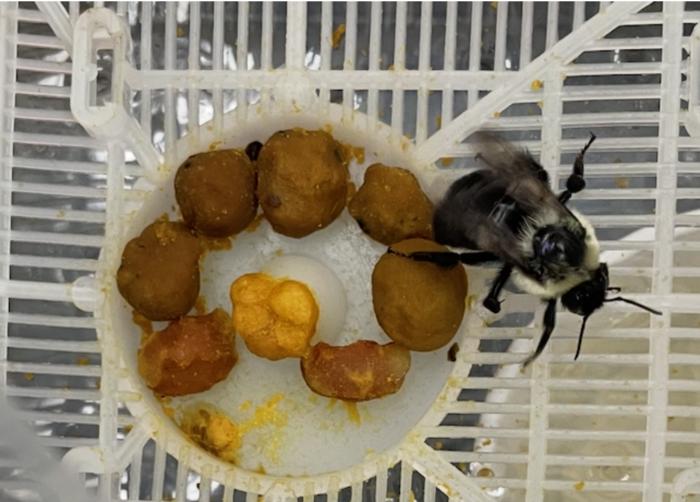In the hidden world of bumble bee colonies, the queen reigns as the architect of survival, tirelessly building the foundation for her future workers. Yet, contrary to the longstanding belief that these queens reproduce relentlessly until their workforce matures, cutting-edge research from the University of California, Riverside reveals a sophisticated biological rhythm. Bumble bee queens, it appears, strategically interrupt their reproductive efforts, pausing egg-laying to carefully manage their energy expenditure during the vulnerable early stages of colony formation.
This groundbreaking study challenges traditional views by illustrating that bumble bee queens do not continuously lay eggs from the moment they initiate a nest. Instead, they exhibit a nuanced pattern: bursts of intense egg production followed by several days of reproductive inactivity. Such pauses likely serve as an adaptive mechanism to prevent physiological burnout, a critical strategy ensuring the queen’s longevity until her first brood is capable of taking over foraging and other essential tasks.
The queens’ extraordinary multitasking during colony foundation involves a demanding set of behaviors. They forage alone for nectar and pollen, incubate their developing brood by generating heat through muscular contractions, construct and maintain the nest’s delicate structure, and simultaneously fulfill their vital role in oviposition. This all-encompassing workload is energetically taxing and pivotal—the entire fate of the colony hinges on the queen’s success in this solitary phase.
Blanca Peto, the lead author and a doctoral student in entomology, first noticed these distinct pauses by daily photographic documentation in controlled laboratory insectaries. “Observing these intentional breaks in egg-laying was unexpected,” Peto notes. Her curiosity propelled the investigation into the underlying biological cues governing this intermittent reproductive timing, a process previously unexplored in bumble bee biology to this depth.
Through meticulous monitoring of over 100 bumble bee queens over a 45-day period, the research team uncovered a consistent recurring pattern. Queens generally ceased egg deposition for multiple days following periods of vigorous egg production. These findings implied a regulatory mechanism synchronized with the developmental progression of the existing brood, suggesting that queens are physiologically attuned to their offspring’s maturation state.
To experimentally probe this hypothesis, the research introduced broods at varying developmental stages—larvae of different ages and pupae—into nests during natural reproductive pauses. The results were compelling: the presence of pupae, bees nearing adulthood, prompted queens to resume laying eggs within approximately 36 hours. In stark contrast, nests without externally added brood extended their reproductive pauses up to an average of 12.5 days. This causative evidence underscores a brood-dependent feedback system influencing queen reproductive behavior.
Such insights fundamentally shift our understanding of eusocial insect reproduction. Conventional wisdom in eusocial biology posits that queens maintain near-constant reproductive output to sustain a continuously overlapping generational structure and cooperative brood care. However, the discovery that bumble bee queens modulate egg production dynamically introduces a previously unrecognized layer of social control and physiological adaptation.
From an evolutionary perspective, this intermittent reproduction strategy may represent an adaptive trait honed to maximize colony survival during the precarious solitary nest-founding phase. By balancing energy allocation between reproduction and other survival activities, queens can potentially avoid the metabolic depletion that would jeopardize the entire colony before worker bees emerge to support the communal tasks.
The implications of this research extend beyond basic biology; they resonate profoundly with conservation efforts. Bumble bee populations across North America face steep declines due to habitat degradation, pesticide exposure, and climate-related stresses. Understanding the intricate life history and reproductive strategies of queens, who establish the genetic and functional roots of each colony, is paramount for devising effective conservation strategies that bolster population resilience.
Intriguingly, the reproductive pauses occurred even under optimal laboratory conditions, where queens neither face foraging dangers nor environmental stresses. This observation indicates that these breaks are not mere responses to external challenges but are ingrained features of bumble bee reproductive physiology and behavior—an intrinsic rhythm essential for colony success.
The study’s reliance on patient, detailed behavioral observation exemplifies the importance of hands-on, longitudinal research in uncovering subtle yet significant biological processes. Each nest photographed daily unveiled a hidden narrative of queen energy management and brood interaction, highlighting the complex dance between individual and colony-level survival tactics.
In highlighting the dynamic reproductive strategies of bumble bee queens, this study opens new avenues for exploring social and physiological regulation in other eusocial insects. Researchers may find parallels in species with solitary queen phases, uncovering conserved mechanisms through which queens optimize reproductive output aligned with brood development stages.
Ultimately, these revelations underscore a critical message: the success of bumble bee colonies—and by extension, ecosystems dependent on their pollination—is intimately tied to the queen’s capacity to manage reproduction judiciously. Their deliberate pauses may well be the secret to enduring the hazardous early days of nest founding and securing the future of these indispensable pollinators.
Subject of Research: Social regulation of reproduction in bumble bee queens during solitary nest-founding
Article Title: Social control of egg-laying in independently nest-founding bumble bee queens
News Publication Date: 9-Apr-2025
Web References: https://bmcecolevol.biomedcentral.com/articles/10.1186/s12862-025-02364-0
Image Credits: Blanca Peto/UCR
Keywords: Bees, Bumble bees, Insects, Arthropods, Invertebrates, Animals, Evolutionary biology, Evolution, Adaptive evolution, Organismal biology




